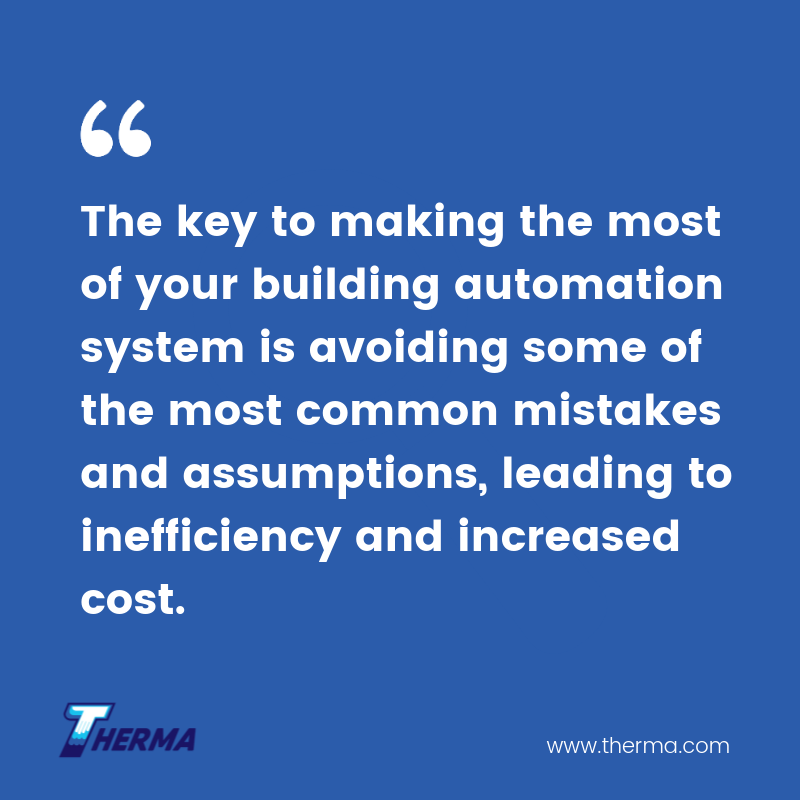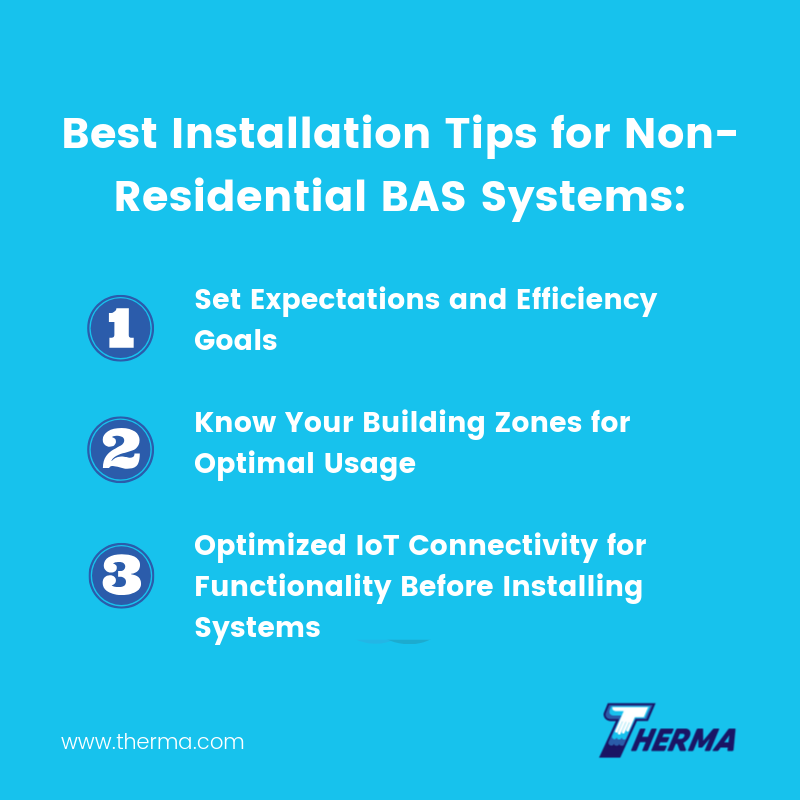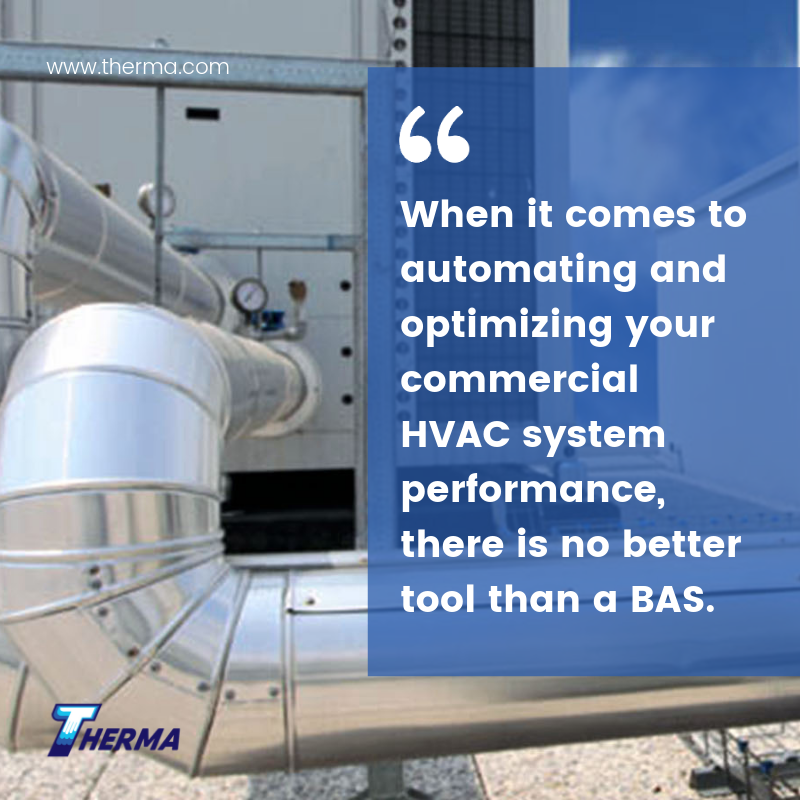Building Automation Systems (BAS) are an interlinked network of hardware and software that work together with an HVAC system (along with other devices) to monitor, control and improve the energy performance in a building.
Building Automation System Mistakes
Through remote monitoring and computerized control, automation systems adjust and monitor a facility’s HVAC system, including heat pumps, chillers, air handlers, and boilers. By connecting to IoT devices and data management frameworks, BAS can collect usage data from various MEP components that can be analyzed and optimized to building conditions, user preference and energy efficiency metering.
When used optimally, BAS bring improved energy efficiency, better ROI through lowering utility bills and operating costs, and increased comfort for building occupants by continually optimizing conditions. The key to making the most of your building automation system is avoiding some of the most common mistakes and assumptions, leading to inefficiency and increased cost.

Best Installation Tips for Non-Residential BAS Systems
- Set Expectations and Efficiency Goals
Before purchasing a building automation system, research your facility needs and current capabilities. Only spend money on what you need. What energy and performance level are you looking to attain? What level of automation will you need? Will you run your building’s MEP systems and climate control through IoT devices? What are the features of your computerized maintenance management system (CMMS)? Understanding these needs going in will allow your consultant to recommend optimal hardware and software.
- Know Your Building Zones for Optimal Usage
HVAC zoning helps maintain a consistent temperature throughout a commercial building by providing different levels of air distribution via electronically-controlled dampers in the ductwork. This is done by dividing a business into areas with common heating and cooling needs throughout the day, and those whose energy needs fluctuate depending on use. Providing this information to your consultant can greatly increase BAS capabilities to automate and adjust performance.
- Optimized IoT Connectivity for Functionality Before Installing Systems
PropTech is increasingly important for understanding building function and maintenance. Many owners are disappointed when their BAS systems are technologically obsolete. By connecting to IoT capabilities, BAS can be enabled to provide many modern metrics essential to business function. These include sub-utility metering data, complex HVAC operational data, modern Indoor Air Quality (IAQ) data, and real-time cloud visualization services.

Maintenance and Operation of BAS for Optimal Commercial HVAC Performance
- Don’t Neglect or Delay Maintenance!
It seems like common sense to schedule regular BAS maintenance, yet it is too often overlooked. Even if the system appears to be running smoothly, regular maintenance services can prevent energy efficiency drop off due to uncalibrated sensors and failed switches. Proactive maintenance can prevent bigger problems down the line, and track performance data analytics for optimal real-time performance.
- Optimize Your Regular Use
BAS systems cannot provide you with energy efficiency if they are not property used. Program temperature control set points based on demand. In a variable air volume (VAV) system, upstream discharge air temperature should vary with system demand. If the right parts of the system aren’t programmed to cool, some will operate in heating mode in the middle of summer or when the building isn’t occupied. In continuously modulated industrial control systems, the proportional-integral (PI) control loops never stop running. If you don’t tune and regularly maintain them, they could short cycle when attaining a set point, the system could short cycle.
- Avoid Running BAS in Fail-Safe Mode for Long Periods
Fail-safe (or manual mode) in BAS systems occurs any time there is a disruption in the communication between the automated servers and system. While this is an important operational bypass to keep building systems running, operating in fail-safe mode long term wastes energy and can significantly increase utility cost. To ensure rapid reactivation, create an internal manual or standard operating procedure for restoring automatic operation as quickly as possible.
- Perform Regular Database Backups
Backups, like ongoing maintenance, are an essential function for maintaining BAS performance and restoring function in the event of failure. Never put BAS databases or backups on the company’s server. It is too risky from a security standpoint, or user error accidentally disrupting system function.
Optimizing Efficiency for HVAC Performance with a “Smart” System
When it comes to automating and optimizing your commercial HVAC system performance, there is no better tool than a BAS. Indeed, when installed and used correctly, most of these systems eventually pay for themselves with savings.

Building Automation System Mistakes – Upgrading
If you are upgrading your BAS, carefully consider whether to install a brand new system or to upgrade your existing “legacy” system. A legacy upgrade can be an economical way to integrate new technology, address a building expansion or accommodating growing user demand demographics, all while extending the life of the existing system. However, use caution when upgrading a BAS system. Review all components of the existing BAS for obsolete parts or programming languages. Make sure HVAC equipment optimizes mechanical and electrical performance. Finally, review facility sensors and measuring devices to reverse-engineer any upgrades according to industry performance standards or mandatory energy efficiency guidelines.
Last, try to avoid installing highly proprietary (or closed) BAS systems. As the integration of IoT components and usage and performance monitoring databases evolves, you might have a harder time connecting these separate systems and parts. A proprietary system might also limit who can service the system and future component upgrades.







